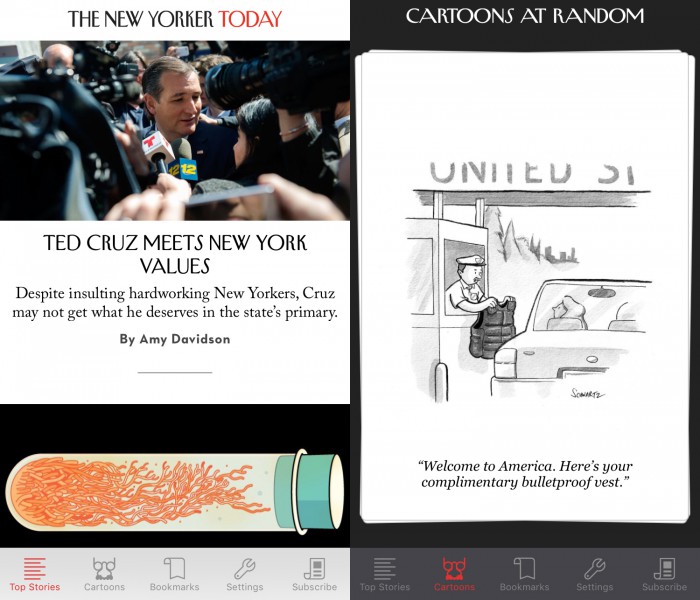
The New Yorker this morning launched The New Yorker Today, a new iPhone app built to offer users an up-to-date look at content from NewYorker.com. Unlike the existing New Yorker app, which is home exclusively to content from the print magazine, the new app will showcase the latest stories, blog posts, and videos from the magazine’s website — in addition to articles from the magazine and its archives.
The app is an extension of The New Yorker’s efforts to increase its presence on the web while also staying true to its history and brand. NewYorker.com editor Nicholas Thompson said the goal is to get more New Yorker readers coming back every day — and, hopefully, convince more of them to subscribe. “Our instinct is that for a brand like ours that has a lot of loyal readers that are reading all the time, it’s very important to give them an extremely quick way to read everything,” he said.
While the app was designed primary to give users an “intentionally basic” and clean reading experience, its “neatest, most crazy” addition, according to Thompson, is “Cartoons at Random,” a feature lets users swipe Tinder-style though 8,000 New Yorker cartoons. (Though, unlike Tinder, swiping left or right isn’t passing judgment on the cartoon’s quality.) The app’s only other major feature is a bookmarking tool that lets users save articles to read later. (It created a somewhat analogous tool for desktop readers last fall.) The New Yorker is making the app free to download and use for its first month. The magazine plans to use that period to figure out how to best optimize the app’s paywall — much as it did with the current NewYorker.com paywall, which asks users to pay up once they’ve read six articles in a month. It’s been an effective strategy so far. In 2015, the first full year the paywall was in effect, The New Yorker saw digital subscriptions increase 43 percent. The New Yorker has yet to determine how its strategy will change with The New Yorker Today, but it’s clear that the magazine is trying to make it as easy as possible for users to subscribe: It takes just two taps to subscribe to NewYorker.com from the app. From the app’s launch piece:The app is available right now on iPhones, and everything, for a while at least, is free. If you’re already a digital subscriber, or you’ve linked your print subscription to our Web site, it’ll be free forever once you log in.
Subscribe to the New Yorker with two easy taps. 👏🏾 to their entire team on this relaunch https://t.co/mU15CawxFt pic.twitter.com/LGh3SRdWd5
— Noah Chestnut (@noahchestnut) April 12, 2016
@noahchestnut Thank you – it goes away once you actually subscribe. We have full access for 30 days while figure out best metering approach
— ᶘ ᵒ㉨ᵒᶅ (@donohoe) April 12, 2016
Publishers — particularly magazine publishers — have had an on-again, off-again relationship with apps over the past few years. While apps were heralded as the ideal way to engage readers on mobile, for most publishers apps are to mobile what the homepage is to desktop: a feature that few people beyond a relatively small core of readers will interact with once, much less on a daily basis.
“I don’t think there is anyone here who isn’t cognizant of all of that,” Thompson said. “But we’re also convinced that if you have the kind of loyal readers that we do, then creating an app like this one makes sense.”